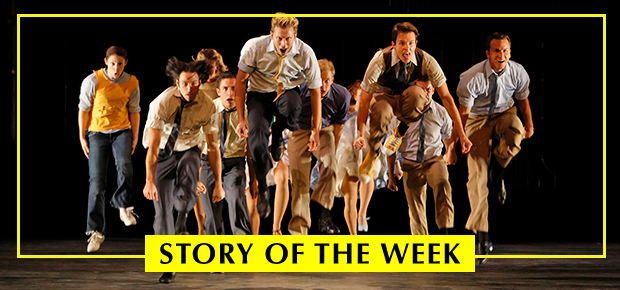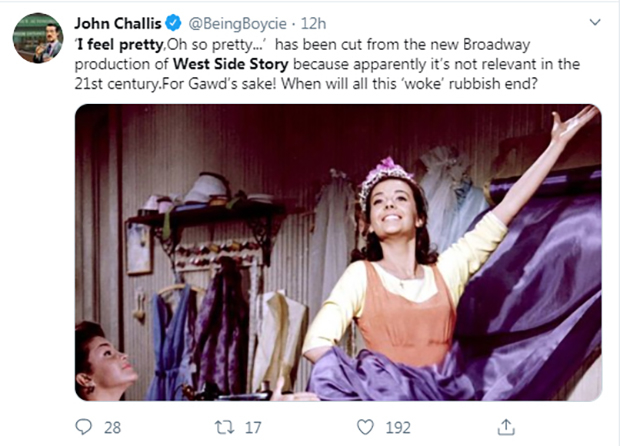Broadway Revival of West Side Story Cuts "I Feel Pretty" and the "Somewhere" Ballet
Belgian experimental theater director Ivo van Hove has big changes planned for the golden-age American musical.

(© Richard Termine)
Since it debuted in 1957, West Side Story has been revived on Broadway four times (if you count the 1960 return engagement), making it one of the most celebrated Broadway musicals ever. Arthur Laurents's book transposes Romeo and Juliet to the west side of northern Manhattan, a territory patrolled by rival gangs of whites and Puerto Ricans. With lyrics by a young Stephen Sondheim and symphonic music by Leonard Bernstein, it has a timeless score boasting songs like "Tonight" and "Maria."
This December, curious Broadway audiences will have the first opportunity to see revival No. 5 when it begins previews at the Broadway Theatre under the direction of Belgian director Ivo van Hove. Speaking with Vogue critic Adam Green (whose father, Adolph Green, collaborated with Bernstein in On the Town), Van Hove revealed some of his plans for the revival: He will employ live video (as he has for his productions of Network and The Damned), he has engaged Anne Teresa De Keersmaeker to create new dances that deviate from Jerome Robbins's Tony-winning choreography, and (most controversially) he will cut "I Feel Pretty" and the "Somewhere" ballet from the score.
This Story of the Week will examine how Van Hove came to these decisions, and how Broadway audiences are likely to react. As you might have guessed, some of the things said about the forthcoming production (which no one has seen) are not very pretty.

(© David Gordon)
Why did they cut "I Feel Pretty" from West Side Story?
Ostensibly, it is to save time. Van Hove notes that the entire story takes place over the course of 48 hours, and he wants nothing to impede the forward motion of the plot, including an intermission (more on that later). Van Hove is renowned for his ability to strip classic dramas to their bare essentials: His A View From the Bridge took place entirely inside a white box, and concluded with a rain of blood. In telling this tale of star-crossed love, Van Hove probably saw these two numbers as nothing more than pretty detours.
Suspecting a darker motive, some observers have been quick to blame the cultural revisionism taking place in the woke wake of the #MeToo movement. Allison Pearson of The Telegraph explains the removal of ''I Feel Pretty" with breathless sarcasm: "Because, as we know, young women of today have ceased caring about their appearance, no longer enjoy getting dressed up for a big night out and are wholly indifferent to their attractiveness to the opposite sex."

While the "I Feel Pretty"-ectomy has provoked outrage from social conservatives and West Side Story purists alike, it couldn't have been possible without the approval of the lyricist himself: Stephen Sondheim. In his book of lyrics and commentary, Finishing the Hat, Sondheim criticizes "I Feel Pretty" for its repetitiveness and lack of substance. He also confesses to exposing his own voice with words like "stunning" and phrases like "an advanced state of shock," something first pointed out to him by none other than Sheldon Harnick (Fiddler on the Roof).
"I quickly rewrote the lyric to make it simpler and more in keeping with the way Maria and the girls expressed themselves in the rest of the score," Sondheim writes, "but my collaborators would have none of it — they liked it the way it was. And is. I have blushed ever since." Now that Sondheim is the last writer standing (the estates of his collaborators have given their blessings to the revisions), it seems unlikely he will shed tears for the death of "Pretty."
But what about the Somewhere ballet?
It's the same reason: It makes the show too long. I must admit, I'm more saddened by the loss of this "dream ballet" — an important innovation of Broadway's golden age (first seen in Oklahoma!) that brought cutting-edge dance to the musical theater.
The "Somewhere" ballet typically comes during the second act: Our lovers, Tony and Maria, make plans to run away together. The accompanying song is about "a place for us," where their love is not constrained by tribalism. The dance shows us that place, and while it need not be the wispy cotton heaven envisioned by Robbins, it serves an important dramatic purpose: It invites us to step away from the circumstances of the play and imagine an alternative. Essentially, it allows us to dream. Without that, all we're left with is grubby realism. I'm curious to see if Van Hove is able to convey the magic and hope inherent in the show in other ways.
Will Broadway audiences accept this?
We won't know until previews begin on December 10 and the first grosses start rolling in. I suspect that the name brand of West Side Story is strong enough to drive major ticket sales without any big names in the cast, and without ticket purchasers knowing much about this revamped production. Whether or not they like what they find once they reach the theater is the big question.

(© Joan Marcus)
A friend's mother who grew up Nuyorican on the west side and who follows the theater avidly recently told him, "I asked you for tickets to Lin-Manuel Miranda's version and you didn't get them, so now I'm stuck with this artsy-fartsy crap." That may be prejudging the show too harshly. Yes, Van Hove comes from the world of avant-garde theater, but it's the kind of avant-garde that can fill the Park Avenue Armory and recoup on Broadway.
We should also remember that when West Side Story debuted in 1957, the Broadway musical was an aggressively sunny artistic form. West Side Story's dark themes and modern dance certainly made the show seem quite experimental — so much so that traditionalist Tony voters snubbed it in favor of The Music Man when it came to the "Best Musical" category.
More than the removal of a song and dance, I'm concerned about the extraction of the intermission, which will push this musical well over two hours without a break, even with the aforementioned cuts. I love a good intermission, and I think the one in West Side Story is particularly necessary, coming right after a major fight and two deaths. The audience needs some time to process what they just saw and reset for the second half.

(© Amblin)
Van Hove's whole point seems to be to deny us that opportunity to catch our breath as this musical tragedy hurtles toward its inevitable conclusion. "I want to make a juggernaut," he told Green. "You feel that these people are running toward their death and there's no escape from it."
But people aren't siege machines, and in absence of an official intermission, theatergoers with temperamental bladders (the average age on Broadway is 40.6) will create their own. I worry that there will be a lot of people climbing over their fellow patrons and rushing up the aisle during the most exciting parts of the second act — not because the show is bad, but because they simply cannot hold it any longer.








